Farewell Dear Isle
Back to Contents of Issue: November 2003
|
|
|
|
by Michael E. Stanley |
|
|
In 1816, two Royal Navy vessels, the Alceste and the Lyra, had borne a part of Lord Amherst's mission to the imperial court at Peking. The two ships were ordered to survey the western coast of the Korean peninsula and the Ryukyu islands. In mid-September, the ships met their first Okinawans -- and the crews were duly impressed, noting their friendly and generous demeanor.
Between that first meeting and the departure of the two vessels, there was an ongoing mutual admiration and lack of friction that has few parallels in the history of Western voyaging and exploration. The journal of Dr. John M'Leod, ship's surgeon aboard the Alceste, recorded the impression left upon the English voyagers: "... The kindness and hospitality of its inhabitants have fixed upon every mind a deep and lasting impression of gratitude and esteem."
Another officer put his feeling into verse: "Farewell, dear Isle! -- on thee may ne'er/ The breath of civil discord blow!/ Far from your shores be every fear,/ And far -- oh! far -- the invading foe!"
But in 1945, as the Empire of Japan tottered toward defeat in World War II, the islands of the once-flourishing Ryukyu Kingdom bristled with Japanese arms, and did indeed feel the tread of "the invading foe." The rest is a history with an especially ironic twist for that apparently unarmed land whose story had so amazed Napoleon.
Today, Okinawa is the least economically viable of Japan's 47 prefectures, and has had a sizable contingent of forward-deployed United States military forces on its soil for almost six decades. In that time, the prefecture has grown considerably from its Third World-like status as a war-ravaged backwater.
In the meantime, 75 percent of the land reserved for use by US military forces in Japan is in the prefecture, the vast majority of it on the same main island that is home to 90 percent of Okinawa's overall population. Better there than here -- or in Kyoto, Fukuoka or Sapporo -- is the attitude demonstrated but never precisely articulated by the Tokyo decision-makers.
It is hard to go cold turkey on an addiction of that scale.
Those two hard truths -- small political presence and reliance on largesse from Tokyo -- ensure that while there are well-orchestrated local choruses of caterwauling about the US military presence, they can have no effect until either Washington or Tokyo, or both, decide to drastically alter their relationship.
In recent months, there has been speculation that some of the units now in Okinawa could move to bases in northern Australia, Guam or the Philippines in very short order. While there are indeed several potential locations, one certain factor is that any move is likely to be made on a large scale. The two major units of the US Forces in Okinawa are the Marine Corps' 3rd Marine Expeditionary Force (III MEF), headquartered at Camp Courtney, and the Air Force's 18th Wing, headquartered at Kadena Air Base. These are large and intricate elements of the total US force structure in the Asian-Pacific region.
Force relocation out of Okinawa would not only be on a large scale, it would be precipitous: these components -- despite their size and complexity -- cannot afford a long down time while they pack, move and unpack. And there are important strategic and tactical aspects to consider: the Pentagon is absolutely unwilling to reveal its forces' movements any more than is necessary. As long as the major threat in the region is only two hours by air (or less than 15 minutes by missile) from Okinawa, it is indeed na•ve in the extreme to think that any long-term advance notice of a major redeployment would be offered. Given these two conditions, it is apparent that any moves in store for the Okinawa-based US military would be both large and relatively sudden. And with US military presence in Okinawa of such a scale that it is deeply woven into the fabric of life on the island, any such move would have a broad-based and potentially devastating economic impact.
At the time of reversion to Japanese sovereignty, military-related transactions accounted for 15.6 percent of the prefecture's total economic activity, for a total of JPY78 billion. In recent years, that same category -- including rent paid for the land occupied by military facilities, salaries of Japanese employees on the bases and the calculated expenditures by the US personnel in the local economy -- has hovered at just about 5 percent, with a total of around JPY180 billion. Much of this, including the salaries of Japanese-national employees and the rental payments to land owners for the use of their "conscripted" property, is actually paid for by the Japanese government.
The US Air Force and Marine Corps together employ about 7,500 Okinawans, with another 1,200 or so employed at the smaller US Army and Navy facilities. This makes the US military one of the prefecture's largest employers; it is fairly easy to envision the impact of the loss of both those jobs and the concomitant economic input by the US military.
With Japan still in its decade-plus recession (and no sign of it ending soon), with tax revenues in a slide and necessary expenditures rising, it requires no mental wizardry to understand the government's aversion to having to further bail out Okinawa. The entire prefecture could suddenly plunge into a depression by the loss of an amount approaching JPY180 billion per year -- not to mention the sudden disappearance of local construction, maintenance and service contracts let for base facilities and paid for by the Japanese government through the Defense Agency's Defense Facilities Administration Agency.
Ishiba may have revealed more than he intended to at the time. As things stand today, the Japan Air Self Defense Force could not do much; but the new -- and air-refuelable -- F-16-based F-2 attack fighter is configured to employ the GPS-guided Joint Direct Attack Munition (JDAM) "smart bomb" system. This combination will multiply Japan's air-strike capabilities by several orders of magnitude, and so make a quick-reaction strike such as that mentioned by Mr. Ishiba well within the capability of the JASDF in very short order. His comments might be hinting that active acquisition of this system is now on the fastest of tracks and that reaching operability at the earliest opportunity is a major priority.
The impact of the sudden relocation of the large Marine and Air Force components from Okinawa would not be limited to that island alone; it would ripple throughout the nation and the region. But the two dollars-and-cents problems that Japan would face are the relief of an Okinawa plunged suddenly into a prefectural depression of unprecedented scale, and the need for the nation to arm and train to thoroughly and completely defend itself in the event of a regional crisis. Whether it is politically up to that challenge is something we may see in the months and years ahead. The days of a chaotically overheated, virtually unmanaged economy and a head-in-the-sand approach to international difficulties should be over, and the real test may just be beginning. @ |
|
Note: The function "email this page" is currently not supported for this page.


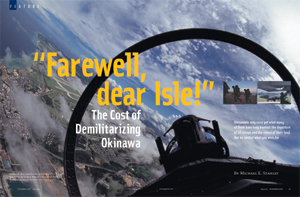 BY THE BEGINNING OF the 19th century, the inhabitants of the Ryukyu Kingdom -- including what are now the 159 islands of Okinawa Prefecture -- were well aware that foreign ships occasionally prowled their waters. Among them were trading vessels bound for the European trading enclaves in the region and a few European and American whalers, who had begun to search out the great pods of leviathans that dwelt in the western Pacific. These vessels came and soon departed, usually without incident, often leaving only puzzlement and speculation in their wake.
BY THE BEGINNING OF the 19th century, the inhabitants of the Ryukyu Kingdom -- including what are now the 159 islands of Okinawa Prefecture -- were well aware that foreign ships occasionally prowled their waters. Among them were trading vessels bound for the European trading enclaves in the region and a few European and American whalers, who had begun to search out the great pods of leviathans that dwelt in the western Pacific. These vessels came and soon departed, usually without incident, often leaving only puzzlement and speculation in their wake.
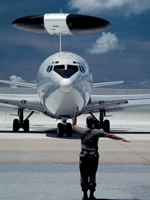 On the homeward voyage, the Lyra put in at the lonely South Atlantic isle of St. Helena, where the exiled Napoleon Bonaparte was in enforced residence. Captain Basil Hall secured an interview with Bonaparte, in which he mentioned that during his stay in the Ryukyus he saw no weapons of any kind. Hall noted that Bonaparte was "... completely perplexed ... Nothing struck him so much as their having no arms." Bonaparte was equally surprised by the Ryukyus' life without war. "'No wars!' cried he, with a scornful and incredulous expression, as if the existence of any people under the sun without wars was a monstrous anomaly."
On the homeward voyage, the Lyra put in at the lonely South Atlantic isle of St. Helena, where the exiled Napoleon Bonaparte was in enforced residence. Captain Basil Hall secured an interview with Bonaparte, in which he mentioned that during his stay in the Ryukyus he saw no weapons of any kind. Hall noted that Bonaparte was "... completely perplexed ... Nothing struck him so much as their having no arms." Bonaparte was equally surprised by the Ryukyus' life without war. "'No wars!' cried he, with a scornful and incredulous expression, as if the existence of any people under the sun without wars was a monstrous anomaly."
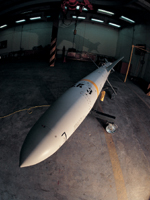 Over the years, the presence of a large number of US military personnel -- approximately 25,000, with about 23,000 dependents -- making exclusive use of 19 percent of the main island's land area has become an increasingly visible source of friction between the Okinawans, the US military personnel stationed there and the government of Japan. Despite the politicians and bureaucrats who dodge the issue every time it is brought forward, it is quite clear that to the Japanese government, the large Okinawa-based forces and their facilities are in that prefecture until it's in their best interest to leave, and no amount of local protest will dislodge them.
Over the years, the presence of a large number of US military personnel -- approximately 25,000, with about 23,000 dependents -- making exclusive use of 19 percent of the main island's land area has become an increasingly visible source of friction between the Okinawans, the US military personnel stationed there and the government of Japan. Despite the politicians and bureaucrats who dodge the issue every time it is brought forward, it is quite clear that to the Japanese government, the large Okinawa-based forces and their facilities are in that prefecture until it's in their best interest to leave, and no amount of local protest will dislodge them.
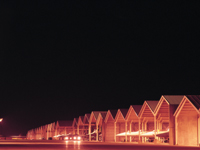 The really telling facts are these: Okinawa has a small population (just over 1,300,000 compared with Tokyo's over 12 million) and comprises only 0.6 per cent of Japan's total land area. Moreover, the prefecture is very heavily dependent on largesse from the national government to keep its books balanced, and must rely on Tokyo handouts on a perennial basis. In the thirty years since the switch from US military occupation to Japanese civilian rule in 1972, the Japanese government spent JPY6.7 trillion on improving Okinawa's infrastructure.
The really telling facts are these: Okinawa has a small population (just over 1,300,000 compared with Tokyo's over 12 million) and comprises only 0.6 per cent of Japan's total land area. Moreover, the prefecture is very heavily dependent on largesse from the national government to keep its books balanced, and must rely on Tokyo handouts on a perennial basis. In the thirty years since the switch from US military occupation to Japanese civilian rule in 1972, the Japanese government spent JPY6.7 trillion on improving Okinawa's infrastructure.
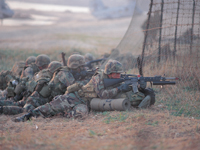 That may come to pass in the very near future. Over the next few years, the US will likely implement a large-scale repositioning of its overseas forces. Despite the official press-release denials, it is far from inconceivable that the forces stationed in Okinawa could well be shifted to other locations in the western Pacific area. Such moves may be much more likely than anyone is letting on at the moment, especially if there is a diplomatic breakthrough -- or a coup d'etat -- that guarantees the stability of the Korean peninsula.
That may come to pass in the very near future. Over the next few years, the US will likely implement a large-scale repositioning of its overseas forces. Despite the official press-release denials, it is far from inconceivable that the forces stationed in Okinawa could well be shifted to other locations in the western Pacific area. Such moves may be much more likely than anyone is letting on at the moment, especially if there is a diplomatic breakthrough -- or a coup d'etat -- that guarantees the stability of the Korean peninsula.
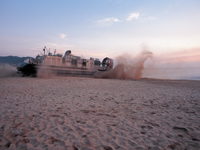 The structure and mission of these two critically important force components are such that the larger part of the US forces in Okinawa cannot be drawn away gradually, a piece at a time. Each has to maintain its function and readiness together. If there is a realignment that causes the 3rd MEF and/or the 18th Wing to relocate, that removal would have to be on a large scale. Fragmentary or small-scale changes of a long-term nature could not occur; neither of these force's components can effectively function if, say, its electronics repair personnel, cooks or military police units were to be removed. The far greater part has to essentially move together, just as a spleen, liver and gall bladder have to move with the rest of a living human body in order for that body to survive. Essentially, it's a case of "all or nothing.'"
The structure and mission of these two critically important force components are such that the larger part of the US forces in Okinawa cannot be drawn away gradually, a piece at a time. Each has to maintain its function and readiness together. If there is a realignment that causes the 3rd MEF and/or the 18th Wing to relocate, that removal would have to be on a large scale. Fragmentary or small-scale changes of a long-term nature could not occur; neither of these force's components can effectively function if, say, its electronics repair personnel, cooks or military police units were to be removed. The far greater part has to essentially move together, just as a spleen, liver and gall bladder have to move with the rest of a living human body in order for that body to survive. Essentially, it's a case of "all or nothing.'"
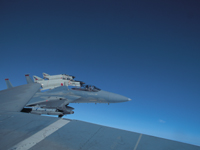 Back during the bubble years of the 80s, the term '3 K' was used to describe work seen as demeaning to the younger Japanese generation: kiken, kitanai, kitsui (dangerous, dirty, harsh). The Okinawan economy has its own different set of Ks: kanko, kichi, kokyo jigyo. These describe the bases of the prefecture's economy -- tourism, the military bases and public-works spending. (Note that agriculture and manufacturing are nowhere in the mix, even with tax incentives aimed at aiding these sectors.)
Back during the bubble years of the 80s, the term '3 K' was used to describe work seen as demeaning to the younger Japanese generation: kiken, kitanai, kitsui (dangerous, dirty, harsh). The Okinawan economy has its own different set of Ks: kanko, kichi, kokyo jigyo. These describe the bases of the prefecture's economy -- tourism, the military bases and public-works spending. (Note that agriculture and manufacturing are nowhere in the mix, even with tax incentives aimed at aiding these sectors.)
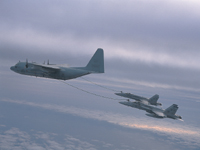 However, these monies are contingent on the presence of the US forces, and whatever the source, for years the total has been more than double the figure for the income generated by Okinawa's agricultural sector. Despite the claims that the bases cause economic hardship by depriving Okinawans of their land, a quick look at the rentals paid for the use of that land reveals that the amounts paid are higher on the average than the profits resulting from sugar cane or pineapple cultivation -- a fact which is grudgingly conceded even by some of the bases' most vociferous opponents. Some of these individuals are owners of the properties themselves. The economic reality of this payment is underlined by the fact that there are Okinawan real estate agencies that specialize in buying and selling titles to individual parcels of the land on which the bases sit.
However, these monies are contingent on the presence of the US forces, and whatever the source, for years the total has been more than double the figure for the income generated by Okinawa's agricultural sector. Despite the claims that the bases cause economic hardship by depriving Okinawans of their land, a quick look at the rentals paid for the use of that land reveals that the amounts paid are higher on the average than the profits resulting from sugar cane or pineapple cultivation -- a fact which is grudgingly conceded even by some of the bases' most vociferous opponents. Some of these individuals are owners of the properties themselves. The economic reality of this payment is underlined by the fact that there are Okinawan real estate agencies that specialize in buying and selling titles to individual parcels of the land on which the bases sit.
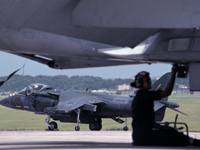 The presence of the Gordian-knot state of tension on the Korean peninsula will assuredly keep the US forces in Okinawa for the time being. However, if the Bush administration's evident coolness toward the apparent threat of a nuclear-armed and nuclear arms-exporting North Korea (as opposed to its fervent heat over a Baathist Iraq) is any indication, a removal of major force components from Okinawa to another location becomes a greater possibility. Such relocation to bases from which they may better be able to operate, say, against Islamic guerillas and terrorists in Southeast Asia is a definite possibility for the near term. The rising profile of Islamic terrorism in that region will be a major motivation. With such large forces tasked and based outside Japanese territory, being unable to "let George do it" will surely provide an impetus for Japan to arm itself more fully so as to be able to mount a far more vigorous defense than the currently eggshell-thin Defense Forces could muster on their own.
The presence of the Gordian-knot state of tension on the Korean peninsula will assuredly keep the US forces in Okinawa for the time being. However, if the Bush administration's evident coolness toward the apparent threat of a nuclear-armed and nuclear arms-exporting North Korea (as opposed to its fervent heat over a Baathist Iraq) is any indication, a removal of major force components from Okinawa to another location becomes a greater possibility. Such relocation to bases from which they may better be able to operate, say, against Islamic guerillas and terrorists in Southeast Asia is a definite possibility for the near term. The rising profile of Islamic terrorism in that region will be a major motivation. With such large forces tasked and based outside Japanese territory, being unable to "let George do it" will surely provide an impetus for Japan to arm itself more fully so as to be able to mount a far more vigorous defense than the currently eggshell-thin Defense Forces could muster on their own.
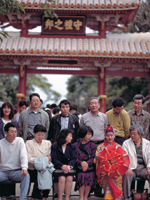 It is already evident that some new and precedent-setting measures in this direction are not only being contemplated, but acted upon. For example, last February, Defense Agency chief Shigeru Ishiba blustered that if Japan's reconnaissance satellites were to detect North Korea fueling its ballistic missiles, Japan could rightly mount a strike against North Korea as an act of self-defense.
It is already evident that some new and precedent-setting measures in this direction are not only being contemplated, but acted upon. For example, last February, Defense Agency chief Shigeru Ishiba blustered that if Japan's reconnaissance satellites were to detect North Korea fueling its ballistic missiles, Japan could rightly mount a strike against North Korea as an act of self-defense.
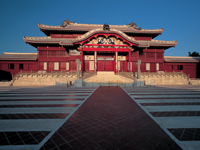 A few years ago, during an interview covering the day-to-day realities of the Japan-US defense relationship, a Japan Air Self Defense Force colonel -- a wing commander at the time -- opined: "In Japan there is no long view; everything is a reaction to the perceived problems of the moment. That is our real problem, and that will hurt us." If the colonel's assessment is indeed accurate, Japan may encounter a painful and dangerous set of difficulties of which there is no apparent precedent.
A few years ago, during an interview covering the day-to-day realities of the Japan-US defense relationship, a Japan Air Self Defense Force colonel -- a wing commander at the time -- opined: "In Japan there is no long view; everything is a reaction to the perceived problems of the moment. That is our real problem, and that will hurt us." If the colonel's assessment is indeed accurate, Japan may encounter a painful and dangerous set of difficulties of which there is no apparent precedent.



